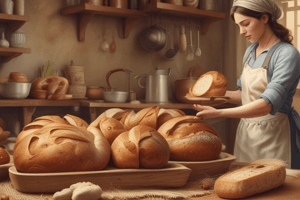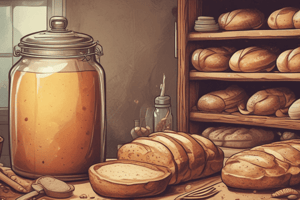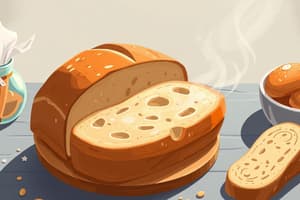Podcast
Questions and Answers
Name two different types of bread and their country of origin.
Name two different types of bread and their country of origin.
Baguette (France), Sourdough (USA)A. Lefse
Ciabatta - ITaly Bagel - Poland Naan - India Focaccia - Italy Chapati - India Pakistan Pita - Greece, Turkey Cottage loaf - UK
The protein that gives bread dough its stretchiness and elasticity is called __________.
The protein that gives bread dough its stretchiness and elasticity is called __________.
gluten
What type of flour is best suited for making bread?
What type of flour is best suited for making bread?
Bread flour. Strong flour
What plant provides us with flour?
What plant provides us with flour?
Which ingredient in bread produces carbon dioxide?
Which ingredient in bread produces carbon dioxide?
What is the proper chemical formula for carbon dioxide?
What is the proper chemical formula for carbon dioxide?
List the four conditions that yeast needs to grow: 1. ___________, 2. ___________, 3. ___________, 4. ___________
List the four conditions that yeast needs to grow: 1. ___________, 2. ___________, 3. ___________, 4. ___________
Yeast is a:
Yeast is a:
Choose the correct spelling:
Choose the correct spelling:
Kneading makes the __________ become __________.
Kneading makes the __________ become __________.
How do you know when dough is ready to be shaped?
How do you know when dough is ready to be shaped?
Name four common shapes for bread rolls.
Name four common shapes for bread rolls.
Explain how you prove bread.
Explain how you prove bread.
List one ingredient you could add to bread to change its: Taste, Texture, and Appearance.
List one ingredient you could add to bread to change its: Taste, Texture, and Appearance.
List three ways bread can be eaten.
List three ways bread can be eaten.
Name three basic pieces of kitchen equipment needed to make bread.
Name three basic pieces of kitchen equipment needed to make bread.
What fat could be replaced by butter or margarine?
What fat could be replaced by butter or margarine?
What ingredient gives bread flavour? What else can it do?
What ingredient gives bread flavour? What else can it do?
What should you use to glaze the top of bread to make it golden brown and shiny?
What should you use to glaze the top of bread to make it golden brown and shiny?
Describe what happens when bread is put into the oven.
Describe what happens when bread is put into the oven.
What adjectives describe water that is approximately 37°C?
What adjectives describe water that is approximately 37°C?
Carbohydrates are broken down into __________ and __________.
Carbohydrates are broken down into __________ and __________.
Why does the body need carbohydrates?
Why does the body need carbohydrates?
List four food sources of carbohydrates.
List four food sources of carbohydrates.
What do the letters NSP stand for?
What do the letters NSP stand for?
How does the body use fibre (NSP)?
How does the body use fibre (NSP)?
Give four food sources rich in fibre.
Give four food sources rich in fibre.
Flashcards
What is Gluten?
What is Gluten?
Protein that gives bread dough its stretch and elasticity.
What is Strong Flour?
What is Strong Flour?
Flour with a higher protein content, ideal for bread making due to gluten development.
What is Wheat?
What is Wheat?
A cereal grain that is a primary source of flour.
What is Yeast?
What is Yeast?
Signup and view all the flashcards
What is CO2?
What is CO2?
Signup and view all the flashcards
What are the 4 conditions yeast needs to grow?
What are the 4 conditions yeast needs to grow?
Signup and view all the flashcards
What is Yeast?
What is Yeast?
Signup and view all the flashcards
What is Dough?
What is Dough?
Signup and view all the flashcards
What does kneading do to the dough?
What does kneading do to the dough?
Signup and view all the flashcards
How do I know the dough is ready to shape?
How do I know the dough is ready to shape?
Signup and view all the flashcards
What is proving?
What is proving?
Signup and view all the flashcards
How can I change the taste of my bread?
How can I change the taste of my bread?
Signup and view all the flashcards
How can I change the texture of my bread?
How can I change the texture of my bread?
Signup and view all the flashcards
How can I change the appearance of my bread?
How can I change the appearance of my bread?
Signup and view all the flashcards
What are some ways to eat bread?
What are some ways to eat bread?
Signup and view all the flashcards
What ‘o’ could be replaced by butter or margarine?
What ‘o’ could be replaced by butter or margarine?
Signup and view all the flashcards
What gives bread some flavor?
What gives bread some flavor?
Signup and view all the flashcards
What do you glaze bread with?
What do you glaze bread with?
Signup and view all the flashcards
What happens when bread enters the oven?
What happens when bread enters the oven?
Signup and view all the flashcards
What is 'tepid' water?
What is 'tepid' water?
Signup and view all the flashcards
What is carbohydrate broken down into?
What is carbohydrate broken down into?
Signup and view all the flashcards
What is carbohydrates needed for?
What is carbohydrates needed for?
Signup and view all the flashcards
What are food sources of carbohydrates?
What are food sources of carbohydrates?
Signup and view all the flashcards
What do the letters NSP stand for?
What do the letters NSP stand for?
Signup and view all the flashcards
How does the body use fibre?
How does the body use fibre?
Signup and view all the flashcards
Study Notes
-
Bread types and their countries of origin vary with examples including:
- Baguette from France
- Sourdough from San Francisco USA
-
Gluten is the protein that makes bread dough stretchy and elastic.
-
Bread flour is best for bread making
-
Flour comes from a plant
-
Yeast produces carbon dioxide in bread.
-
The chemical formula for carbon dioxide is CO2.
-
Yeast needs specific conditions to grow:
- Warmth
- Moisture
- Food (sugar)
- Time
-
Yeast is a single-celled organism.
-
The correct spelling of the mixture of flour and liquid is "dough."
-
Kneading develops the gluten, making the dough smooth and elastic.
-
Dough is ready to be shaped when it has doubled in size and springs back slowly when poked.
-
Bread roll shapes include:
- Round
- Knotted
- Plaited
- Long/Torpedo
-
Proving bread involves letting it rise in a warm place.
-
Taste, texture, and appearance of bread can be altered by adding ingredients:
- Taste: Herbs, spices, cheese, or fruits
- Texture: Seeds, nuts, or grains
- Appearance: Glazes, different flours, or toppings
-
Bread can be eaten in many ways, whether it's:
- Sandwiches
- Toast
- As an accompaniment to meals, or used in dishes
-
Equipment needed for basic bread making includes:
- Mixing bowls
- Measuring tools
- Baking trays.
-
"Oil" could be replaced by butter or margarine.
-
Salt gives bread flavor.
-
Other additions for flavoring bread include herbs and spices
-
An egg wash is used to glaze the top of the bread to make it golden brown and shiny.
-
When bread is put into the oven:
- The yeast rapidly produces gas, the dough rises quickly in a process known as "oven spring"
- The starches gelatinize
- The crust browns due to the Maillard reaction
-
Tepid, hand-hot, or lukewarm water is around 37-40°C
-
Carbohydrates break down into glucose and energy.
-
The body needs carbohydrates for energy.
-
Food sources of carbohydrates include:
- Bread
- Pasta
- Rice
- Potatoes
-
NSP stands for non-starch polysaccharides.
-
Fibre, or NSP, aids digestion and promotes bowel regularity.
-
Food sources of fibre include:
- Whole grains
- Fruits
- Vegetables
- Legumes
-
Bread Machine:
- Advantages: convenient, automated, consistent results and require less effort and time
- Disadvantages: Limited control over ingredients and shaping, can be expensive, and may not produce the same quality as handmade bread
-
Hand Making:
- Advantages: Full control over ingredients and techniques, allows for creativity and skill development, and can be more satisfying
- Disadvantages: Time-consuming, requires more effort and skill, and results may vary
Studying That Suits You
Use AI to generate personalized quizzes and flashcards to suit your learning preferences.




